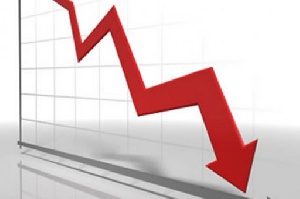Headline inflation for the month of May 2017 has dropped to 12.6 percent from the 13 percent recorded in the previous month, latest figures released by the Ghana Statistical Service (GSS) yesterday, have shown.
The current slip represents a 0.4 percentage point lower than the figure recorded in April. The monthly change rate in May was 0.7 while that for April was 1.6 percent.
Acting Government Statistician, Mr. Baah Wadieh, announcing the figure at a media briefing in Accra explained that a slight change in fuel prices in May resulted in the current declines in both the prices and the inflation of the components in the food and non-food baskets.
“Inflation reduced for almost all the major subgroups, and a significant driver was the price in fuel which recorded a slight decline in price and in inflation. And I think that might have triggered a reduction in inflation rates of all the goods,” said Mr. Wadieh.
The food and non-alcoholic beverages group recorded a year-on-year inflation rate of 6.3 percent, representing a 0.4 percentage points lower than that recorded in April 2017. Two sub-groups under this group recorded inflation rates higher than the group’s average rate of 6.3 percent.
The other group, food, recorded a year-on-year inflation rate of 15.8 percent in May 2017, compared to the 16.3 percent recorded in April. Five subgroups recorded inflation rate higher than the group’s average rate of 15.8 percent.
The transport sector recorded the highest inflation rate of 23.6 percent, followed by recreation and culture with 21.4 percent.
Furnishings, household equipment and routine maintenance also recorded 20.7 percent; and clothing and footwear trailed with 16.5 percent. Housing, electricity, gas and other fuels, however, recorded the least rate of 7.4 percent in the subgroup.
The inflation rate for imported items also recorded 14.5 percent, a 2.7 percentage points higher than that of locally produced items 11.8 percent.
Narrowing it down to the regional level, five regions, Greater Accra, Upper West, Ashanti, Brong Ahafo, and Western recorded rates higher than the national average of 12.6 percent.
Greater Accra recorded the highest year-on-year inflation rate of 13.6 percent, followed by Upper West with 13.5, while the Upper East recorded the lowest of 9.1 percent.
Business News of Thursday, 15 June 2017
Source: thebftonline.com

















